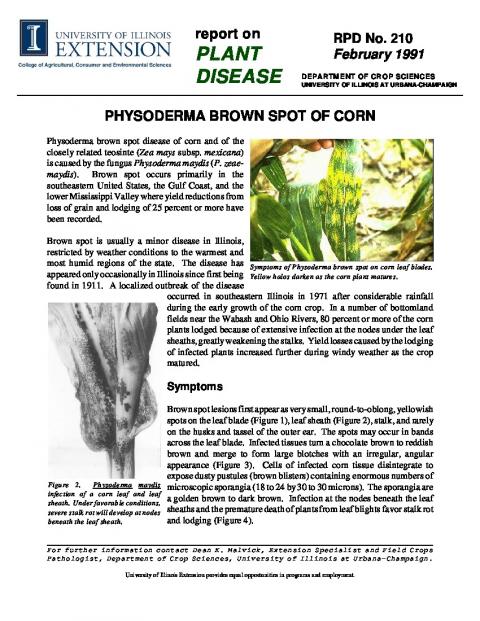For further information contact Dean K. Malvick, Extension Specialist and Field CropsPathologist, Department of Crop Sciences, University of Illinois at Urbana-Champaign.University of Illinois Extension provides equal opportunities in programs and employment.Symptoms of Physoderma brown spot on corn leaf blades.Yellow halos darken as the corn plant matures. Figure 2. Physoderma maydisinfection of a corn leaf and leafsheath. Under favorable conditions,severe stalk rot will develop at nodesbeneath the leaf sheath.PHYSODERMA BROWN SPOT OF CORNPhysoderma brown spot disease of corn and of theclosely related teosinte (Zea mays subsp. mexicana)is caused by the fungus Physoderma maydis (P. zeae-maydis). Brown spot occurs primarily in thesoutheastern United States, the Gulf Coast, and thelower Mississippi Valley where yield reductions fromloss of grain and lodging of 25 percent or more havebeen recorded.Brown spot is usually a minor disease in Illinois,restricted by weather conditions to the warmest andmost humid regions of the state. The disease hasappeared only occasionally in Illinois since first beingfound in 1911. A localized outbreak of the diseaseoccurred in southeastern Illinois in 1971 after considerable rainfallduring the early growth of the corn crop. In a number of bottomlandfields near the Wabash and Ohio Rivers, 80 percent or more of the cornplants lodged because of extensive infection at the nodes under the leafsheaths, greatly weakening the stalks. Yield losses caused by the lodgingof infected plants increased further during windy weather as the cropmatured.SymptomsBrown spot lesions first appear as very small, round-to-oblong, yellowishspots on the leaf blade (Figure 1), leaf sheath (Figure 2), stalk, and rarelyon the husks and tassel of the outer ear. The spots may occur in bandsacross the leaf blade. Infected tissues turn a chocolate brown to reddishbrown and merge to form large blotches with an irregular, angularappearance (Figure 3). Cells of infected corn tissue disintegrate toexpose dusty pustules (brown blisters) containing enormous numbers ofmicroscopic sporangia (18 to 24 by 30 to 30 microns). The sporangia area golden brown to dark brown. Infection at the nodes beneath the leafsheaths and the premature death of plants from leaf blights favor stalk rotand lodging (Figure 4).DEPARTMENT OF CROP SCIENCESUNIVERSITY OF ILLINOIS AT URBANA-CHAMPAIGNreport onPLANT DISEASERPD No. 210February 1991
-2-Figure 3. Close-up of a corn leaf blade showingthe chocolate brown blotches, an advanced stageof Physoderma brown spot. Infected corn tissuescontain large numbers of sporangia that may bereleased as the corn leaf ruptures and dies. Brownspot symptoms are most prominent in the leafmidrib area.Figure 4. Severe stalk rotting and lodging mayoccur when Physoderma maydis invades the nodesof susceptible corn hybrids. (Courtesy G.L.Scheifele)Disease CycleThe thick-walled, brown sporangia (resting spores) formedwithin infected cells enable P. maydis to overseason in corndebris or in the soil. The sporangia are released frominfection pustules, disintegrating corn debris, and soil and arecarried to susceptible plants by air currents, insects, splashingrain or flowing water, and humans. Corn becomesincreasingly susceptible to Physoderma until the plants areabout 45 to 50 days old; susceptibility declines steadily afterthat.Free water is required for infection. When moisture is presentin the whorl or behind the leaf sheaths and temperatures arerelatively high (73° to 90°F, 23° to 30°C), a sporangium“germinates” to release 20 to 50 swimming zoospores. Thezoospores move about in water for 1 to 2 hours before settlingdown, becoming amoeba-like, and penetrating yongmeristematic tissue with fine infection hyphae. The resultingmycelium enters mesophyll or parenchyma cells and formslarger, vegetative structures (Figure 5). Infection commonlyoccurs in a diurnal cycle, resulting in alternating lateral bandsof infected and healthy leaf tissue as it emerges from thewhorl. Zoospores of P. maydis can infect corn tissue onlyduring certain hours of the day and within a few hours afterbeing released. The development of symptoms and the ger-mination of new sporangia occur approximately 6 to 20 daysafter infection, completing the disease cycle (Figure 5).Figure 5. Stages in the life cycle of Physoderma maydis as seenthrough a high-power microscope. Stages a through g can occurin as short a period as 16 to 20 days. (a Two sporangia (restingspores), top view and side view. (b) stage in opening of asporangium, showing the early stage of zoospore formation.Note the dehisced operculum (lid) being carried up by theenlarging sporangium. (c) Mature zoospores escaping throughthe ruptured apex of the resting spore. (d) Three zoospores witha single flagellum from a germinated resting spore. (e)Germinating zoospores, amoeboid stage. (f) Rhizomyceliumwithin a corn epidermal cell showing young sporangia at theends of short hyphae. (g) Corn leaf cell filled with matureresting sporangia (Drawing by Lenore Gray).
-3-Control1.Plant resistant hybrids and varieties adapted to your area.2.Shred infected corn debris in the fall and chisel plow. Tillage may be done in the fall or spring,depending on the conservation tillage practices recommended for the area.3.Avoid planting known susceptible varieties in river-bottom soils or other high-humidity locations.4.Rotate crops, since this may contribute to a reduction of inoculum. Physoderma is known to remainviable in the soil, as sporangia, for about 3 years. Spore-trapping data indicate that the sporangia canbe blown or carried long distances and be spread easily to adjacent fields. Infected plants transportedfor silage can also move considerable numbers of sporangia into disease-free areas.
-4-
This resource originates from https://ipm.illinois.edu…. Click on this link to download from the source. If the original link doesn´t work, click on the image in the box on the right and download a copy.

